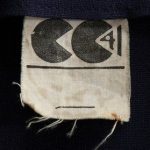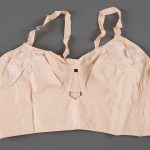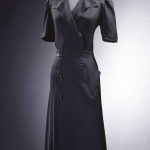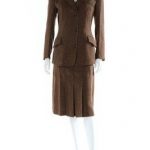Utility Clothing. During World War II, severe shortages of commodities including food, clothing, petrol and furniture lead to the issue of ration books to evenly share what was available. Clothes rationing was introduced on 1 June 1941.
Never before in English history had such control been exercised over British manufacturing. A discussion related to the ethical approach to design by British critic J M Richards proposed that regulation of the clothing industry created an “opportunity to instil an appreciation of Good Design in the general population.”
Under wartime emergency powers, by order of the Board, the distinctive ‘CC41’ label was to be printed, stamped or attached next to the manufacturers label to all cloth and ready-made clothing that was produced under the Scheme’s directives. In addition, all utility fabric was given a specification number which related to quality and type of garment it was to be used for. This number stayed with the garment through manufacture and retailing enabling the Board to ensure adherence to its pricing policy.
Initially 60 coupons were allocated for each person; however this was subsequently reduced to 48. The development of a clothing policy allowed for the manufacture of
only utility corsetry which reduced the amount of raw materials used. Austerity measures banned wasteful embellishments such as frills, pleats, decorative ribbons and the inclusion of steel supports was limited.
Rationing continued long after the war ended in 1945. The Utility Scheme aimed at ensuring the production of necessary clothing requirements under price controlled conditions lasted until 1952 and the subsequent controls exercised by the D Scheme over manufacturing and selling continued until 1955. Reference: Museum of Applied Arts and Sciences
The British “Utility Suit” and American “Victory Suit” were both made of wool-synthetic blend yarns, without pleats, cuffs (turn-ups), sleeve buttons or patch pockets; jackets were shorter, trousers were narrower, and double-breasted suits were made without vests (waistcoats). Reference: Wikipedia
The CC41 Utility logo was a British Board of Trade requirement that appeared on footwear, utility furniture, textiles and utility clothing for just over ten years from 1941. Per a 1941 Associated Press article, CC41 meant “Controlled Commodity”, and designated that the item met the government’s austerity regulations. The CC41 logo was designed by Reginald Shipp
Reference: Wikipedia
Size 38 womens utility bra, England Made by in England, United Kingdom, Europe, 1941-1955.
Reference: Museum of Applied Arts and Science
Black day dress
In 1942 the British Board of Trade commissioned ten members of the recently formed Incorporated Society of London Designers to create a collection of regulation day wear under the auspices of the Utility scheme, an austerity measure introduced by the Board of Trade during the Second World War, when clothes were rationed. Smart yet practical, this shirtwaister – a kind of tailored shirt-dress – was the only black garment in the designer Utility collection. The rayon crepe dress has all the characteristics of wartime clothing – broad shoulders (shaped by heavy flock pads), a skirt length just below the knee and a square silhouette, but it also has also eye-catching details, such as bold lapels and a roomy pocket set diagonally on the left hip.
Reference: © Victoria and Albert Museum
A group of World War Two utility men’s suits and a coat, all with CC41 labels Including two black wool two-piece evening suits, the jacket lapels of ribbed silk, the trousers trimmed with silk braid; a navy blue pinstripe three-piece suit by Simpson; a navy blue pinstripe two-piece suit; a brown wool tweed two-piece suit, with braces; a navy wool two-piece suit by Hepworths of Leeds and London and a brown wool greatcoat. (14)
Sold for £ 1,020 inc. premium at Bonham’s in 2011
A Clarissa Models Utility lady’s brown tweed suit, 1940s, CC41 label and also original CC41 shop tag for £7.6.5 with 18 coupons, chest 92cm, 36in, waist 71cm, 28in; together with a yellow linen blouse and a chevron weave wool skirt, both with CC41 labels (4) CONDITION • Clarissa Models tweed suit is unworn and with original card swing tag, damp speckles to pink rayon label, exterior is fresh and good • Yellow Bernella Moygashel linen blouse – good condition, tiny spot stain to right chest area (minor) • Glenhar herringbone weave skirt – good condition, no problems
Sold for £1,700 at Kerry Taylor Auctions in 2015
[geolocator_show for=”GB”][ebayfeedsforwordpress feed=”http://rest.ebay.com/epn/v1/find/item.rss?keyword=utility&categoryId1=182047&sortOrder=BestMatch&programid=15&campaignid=5338620288&toolid=10039&customid=pastimefashions-rss-uk-utility&listingType1=All&feedType=rss&lgeo=1″ items=”20″][/geolocator_show]
[geolocator_hide for=”GB”][ebayfeedsforwordpress feed=”http://rest.ebay.com/epn/v1/find/item.rss?keyword=utility+1940s&categoryId1=175759&sortOrder=BestMatch&programid=1&campaignid=5338620289&toolid=10039&customid=pastimefashions-rss-us-utility&listingType1=All&feedType=rss&lgeo=1″ items=”20″][/geolocator_hide]





